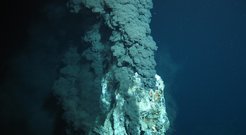Methane formation before the emergence of life
Researchers show how methane formed in early Earth's aquatic environments and is still released today
A team at the Max Planck Institute for Terrestrial Microbiology in Marburg has found that iron and reactive oxygen species drive the formation of methane in aqueous environments. In Earth's early history, this non-enzymatic process probably favored the emergence of life. Today, this mechanism could still contribute to methane production.

Methane (CH4) has been involved in warming the atmosphere since early Earth history. At that time, the methane haze kept the planet from freezing and was one of the prerequisites for the emergence of life. Methane is a particularly potent greenhouse gas: it drives global warming 80 times more than the same amount of carbon dioxide (CO₂). To better assess and predict human-induced climate change, researchers around the world are working to identify sources of methane formation.
In 2022, scientists at the Max Planck Institute for Terrestrial Microbiology in Marburg, together with a team from the University of Heidelberg, Germany, discovered that methane is produced in all organisms. The core of the process is the so-called Fenton reaction, a reaction of hydrogen peroxide (H2O2) with reduced iron (Fe2+), which leads to highly reactive compounds and radicals, which are capable of splitting off methane from organic sulfur and nitrogen compounds.
"Since the cellular process is not catalyzed by enzymes, we wondered whether it could happen outside cells," says Dr. Johannes Rebelein, head of the Emmy Noether Research Group at the Max Planck Institute. It turns out that the process also takes place in the inanimate environment. In the absence of oxygen, both light and heat contribute to the formation of H2O2 in aqueous solutions. In addition to methane, ethane, C2H6, is also formed by the combination of two methyl radicals.
It is noteworthy that methane is formed from organic sulfur compounds, such as dimethyl sulfoxide, via the Fenton reaction. Such compounds are found at hydrothermal vents in the deep sea, better known as "black smokers".
Until now, a specific geological process called serpentinization was thought to be responsible for methane formation in the deep sea. "The fact that methane can be formed on the ocean floor via the Fenton reaction is a finding that surprised us," says Johannes Rebelein. "Unlike serpentinization, the process we have identified is not spatially restricted. It could basically take place in all wetlands on Earth, because heat and light drive it under ambient temperatures and pressure conditions." The researchers also believe that this process could contribute and explain the "oceanic methane paradox". The "oceanic methane paradox" refers to the light-dependent emission of methane from water bodies in the presence of oxygen - unlike the anoxic/anaerobic microbial methane production.
The researchers showed that biomolecules further enhanced methane production. "In our experiments, the binding of reduced iron to biomolecules increased the activity of the Fenton reaction. This means that after the emergence of life, the process probably increased in intensity because the biomolecules could serve as both substrates and iron-binding activators," explains Leonard Ernst, lead author of the current study. The research was conducted in cooperation with the Institute of Geosciences at Heidelberg University, the Microcosm Earth Center in Marburg and the German Cancer Research Institute in Heidelberg.
The work lays the foundation for further research on the evolution of the Earth's atmosphere. It is also necessary to clarify to what extent this mechanism contributed and still contributes to the overall methane release.












